Climate Change and Overuse: Water Resource Challenges during Economic Growth in Coquimbo, Chile
Abstract
:1. Introduction
2. Materials and Methods
2.1. Study Domain
2.2. Data Synthesis and Trend Analysis
3. Results
4. Discussion
5. Conclusions
Author Contributions
Funding
Institutional Review Board Statement
Informed Consent Statement
Data Availability Statement
Acknowledgments
Conflicts of Interest
References
- Agudelo, R. El agua recurso estratégico del siglo XXI. Fac. Nac. Salud Pública 2005, 23, 92–102. [Google Scholar]
- Canales, A.; Canales, M. Población y territorio en el modelo económico chileno. El caso de la comarca del Aconcagua. Pap. Población 2016, 88, 9–46. [Google Scholar]
- Aitken, D.; Rivera, D.; Godoy, A.; Holzapfel, E. Water scarcity and the impact of the mining and agricultural sectors in Chile. Sustainability 2016, 8, 128. [Google Scholar] [CrossRef] [Green Version]
- Valdés-Pineda, R.; Pizarro, R.; García-Chevesich, P.; Valdés, J.; Olivares, C.; Vera, M.; Balocchi, F.; Pérez, F.; Vallejos, C.; Fuentes, R.; et al. Water governance in Chile: Availability, management and climate change. J. Hydrol. 2014, 519, 2538–2567. [Google Scholar] [CrossRef]
- Budds, J. Contested H2O: Science, policy and politics in water resources management in Chile. Geoforum 2009, 40, 418–430. [Google Scholar] [CrossRef]
- Arumí, R.; Oyarzún, L. Las aguas subterráneas en Chile. Boletín Geol. Min. 2006, 117, 34–45. [Google Scholar]
- Ministerio del Interior y Seguridad Pública. Política Nacional para los Recursos Hídricos. 2015. Available online: https://www.interior.gob.cl/media/2015/04/recursos_hidricos.pdf (accessed on 9 January 2021).
- Oyarzún, J.; Oyarzún, R. Sustainable development threars, inter-sector conflicts and environmental policy requirements in the arid, mining rich, northern Chile territory. Sustain. Dev. 2009, 19, 263–274. [Google Scholar] [CrossRef]
- Boisier, J.; Rondanelli, R.; Garreaud, R.; Muñoz, F. Anthropogenic and natural contributions to the southeast pacific precipitation decline and recent megadrought in central Chile. Geophys. Res. Lett. 2016, 43, 413–421. [Google Scholar] [CrossRef] [Green Version]
- Garreaud, R.; Alvarez-GArreton, C.; BArichivich, J.; Boisier, J.; Christie, D.; Galleguillos, M.; LeQuesne, C.; McPhee, J.; Zambrano-Bigiarini, M. The 2010–2015 mega drought in Central Chile: Impacts on regional hydroclimate and vegetation. Hydrol. Earth Syst. Sci. 2017, 21, 6307–6327. [Google Scholar] [CrossRef] [Green Version]
- González, M.; Gómez, S.; Lara, A.; Garreaud, R.; Díaz, I. The 2010–2015 megadrought and its influence on the fire regime in central and south-central Chile. Ecosphere 2018, 9, e02300. [Google Scholar] [CrossRef] [Green Version]
- Sarricolea, P.; Herrera, M.; Meseguer, O. Climatic regionalisation of continental Chile. J. Maps 2017, 13, 66–73. [Google Scholar] [CrossRef]
- Moncada, X.; Plaza, D.; Stoll, A.; Payacan, C.; Seelenfreund, D.; Martínez, E.; Bertin, A.; Squeo, F. Genetic diversity and structure of the vulnerable specie Prosopis chilensis (Molina) stuntz in the Coquimbo region, Chile. Gayana Bot. 2019, 76, 91–104. [Google Scholar] [CrossRef] [Green Version]
- Ahmad, I.; Tang, D.; Wang, T.; Wang, M.; Wagan, B. Precipitation Trends over Time Using Mann-Kendall and Spearman’s rho Tests in Swat River Basin, Pakistan. Adv. Meteorol. 2015, 2015, 431860. [Google Scholar] [CrossRef] [Green Version]
- Sangüesa, C.; Pizarro, R.; Ibañez, C.; Pino, J.; Rivera, D.; García-Chevesich, P.; Ingram, B. Spatial and Temporal Analysis of Rainfall Concentration Using the Gini Index and PCI. Water 2018, 10, 112. [Google Scholar] [CrossRef] [Green Version]
- Cabral, J.; Lucena, R. Analysis of precipitation using Mann-Kendall and Kruskal-Wallis non-parametric tests. Mercator-Rev. Geogr. UFC 2020, 19, 1–15. [Google Scholar]
- Abera-Abdi, D.; Ayenew, T. Evaluation of the WEAP model in simulating subbasins hydrology in the Central Rift Valley basin, Ethiopia. Ecol. Processes 2021, 10, 41. [Google Scholar] [CrossRef]
- Hervis-Granda, G.; Geler-Roffe, T.; Díaz-García, R.; Amestoy, I.; Cretas, E. WEAP model: Hydrological planning tool dor climate change adaptation. Rev. Ing. Agrícola 2018, 8, 40–47. [Google Scholar]
- Álvarez, P.; Norambuena, S. Manual de Operaciones para la Junta de Vigilancia del río Elqui y sus Afluentes. Laboratorio PROMMRA, Universidad de La Serena. Proyecto FIA PYT 2019, 2017, 0215. [Google Scholar]
- Gobierno Regional—Región de Coquimbo; CONIC Consultores e Ingeniería. Diagnóstico Plan Maestro para la Gestión de Recursos Hídricos, Región de Coquimbo. 2013. Available online: https://snia.mop.gob.cl/repositoriodga/handle/20.500.13000/4329 (accessed on 5 January 2020).
- Valois, R.; MacDonell, S.; Núñez, J.; Maureira, H. Groundwater level trends and recharge event characterization using historical observed data in semi-arid Chile. Hydrol. Sci. J. 2020, 65, 597–609. [Google Scholar] [CrossRef]
- Souvignet, M.; Oyarzún, R.; Verbist, K.; Gaese, H.; Heinrich, J. Hydro-meteorological trends in semi-arid north-central Chile (2–32° S): Water resources implications for fragile Andean region. Hydrol. Sci. J. 2012, 57, 479–495. [Google Scholar] [CrossRef] [Green Version]
- Favier, V.; Falvey, M.; Rabatel, A.; Praderio, E.; López, D. Interpreting discrepancies between discharge and precipitation in high-altitude area of Chile’s Norte Chico region (26–32° S). Water Resour. Res. 2009, 45, W02424. [Google Scholar] [CrossRef] [Green Version]
- Garreaud, R.; Boisier, J.; Rondanelli, R.; Montecinos, A.; Sepúlveda, H.; Veloso-Aguila, D. The Central Chile Mega Drought (2010–2018): A climate dynamics perspective. Int. J. Climatol. 2020, 40, 421–439. [Google Scholar] [CrossRef]
- Verbist, K.; Robertson, A.; Cornelis, W.; Gabriels, D. Seasonal predictability of daily rainfall characteristics in central northern Chile for dry-land management. J. Appl. Meteorol. Climatol. 2010, 49, 1938–1955. [Google Scholar] [CrossRef] [Green Version]
- Montecinos, S.; Gutiérrez, J.; López, F.; López, D. Climatic characteristics of the semi-arid Coquimbo region in Chile. J. Arid Environ. 2016, 126, 7–11. [Google Scholar] [CrossRef]
- Chen, Z.; Grasby, S. Impact of decadal and century-scale oscillations on hydroclimate trend analyses. J. Hydrol. 2009, 365, 122–133. [Google Scholar] [CrossRef]
- Ministerio de Obras Públicas (MOP). Estimacion de la Demanda Actual, Proyecciones Futuras y Caracterización de la Calidad de los Recursos Hídricos en Chile. 2017. Available online: https://dga.mop.gob.cl/Estudios/04%20Resumen%20Ejecutivo/.Resumen%20Ejecutivo.pdf (accessed on 5 January 2020).
- Meadows, D.; Meadows, D.; Randers, J.; Behrens, W. The Limits to Growth: A Report for the Club of Rome’s Project on the Predicament of Mankind; Universe Books: New York, NY, USA, 1972. [Google Scholar]
- Gu, A.; Zhang, Y.; Pan, B. Relationship between industrial water use and economic growth in China: Insights from an environmental Kuznets curve. Water 2017, 9, 556. [Google Scholar] [CrossRef] [Green Version]
- Hemati, A.; Mehrara, M.; Sayehmiri, A. New Vision on the Relationship between Income and Water Withdrawal in Industry Sector. Nat. Resour. 2011, 2, 191–196. [Google Scholar] [CrossRef] [Green Version]
- Duarte, R.; Pinilla, V.; Serrano, A. Looking backward to look forward: Water use and economic growth from a long-term perspective. Appl. Econ. 2014, 46, 212–224. [Google Scholar] [CrossRef] [Green Version]
- Valdés-Pineda, R.; Garcia-Chevesich, P.A.; Alaniz, A.J.; Venegas-Quiñones, H.L.; Valdés, J.B.; Pizarro, R. The Impact of a Lack of Government Strategies for Sustainable Water Management and Land Use Planning on the Hydrology of Water Bodies: Lessons Learned from the Disappearance of the Aculeo Lagoon in Central Chile. Sustainability 2022, 14, 413. [Google Scholar] [CrossRef]
- Muñoz, A.; Klock-Barría, K.; Álvarez-Garretón, C.; Aguilera-Betti, I.; González-Reyes, A.; Lastara, J.; Chávez, R.; Barría, P.; Christie, D.; Rojas-Badilla, M.; et al. Water crisis en Petroca Basin, Chile: The combined effects of a mega-drought and water management. Water 2020, 12, 648. [Google Scholar] [CrossRef] [Green Version]
- Duran-Llacer, I.; Munizaga, J.; Ruybal, c.; Aguayo, M.; Sáez-Carrillo, K.; Arriagada, L.; Rojas, O. Lessons to be learned: Groundwater depletion in Chile’s Ligua and Petorca watersheds through an interdisciplinary Approach. Water 2020, 12, 2446. [Google Scholar] [CrossRef]
- Alam, S.; Gebremichael, M.; Li, R.; Dozier, J.; Lettenmaier, D. Climate change on groundwater storage in the Central Valley, California. Clim. Chang. 2019, 157, 387–406. [Google Scholar] [CrossRef]
- Oficina de Estudios y Políticas Agrarias (Odepa). Estadísticas de Frutales, Superficie Plantada Nacional. Available online: https://www.odepa.gob.cl/estadisticas-del-sector/estadisticas-productivas (accessed on 5 January 2020).
- Donoso, G. Gestión de los recursos hídricos en la agrícultura de Chile y sus desafíos. Int. J. Agric. Nat. Resour. 2021, 48, 171–185. [Google Scholar]
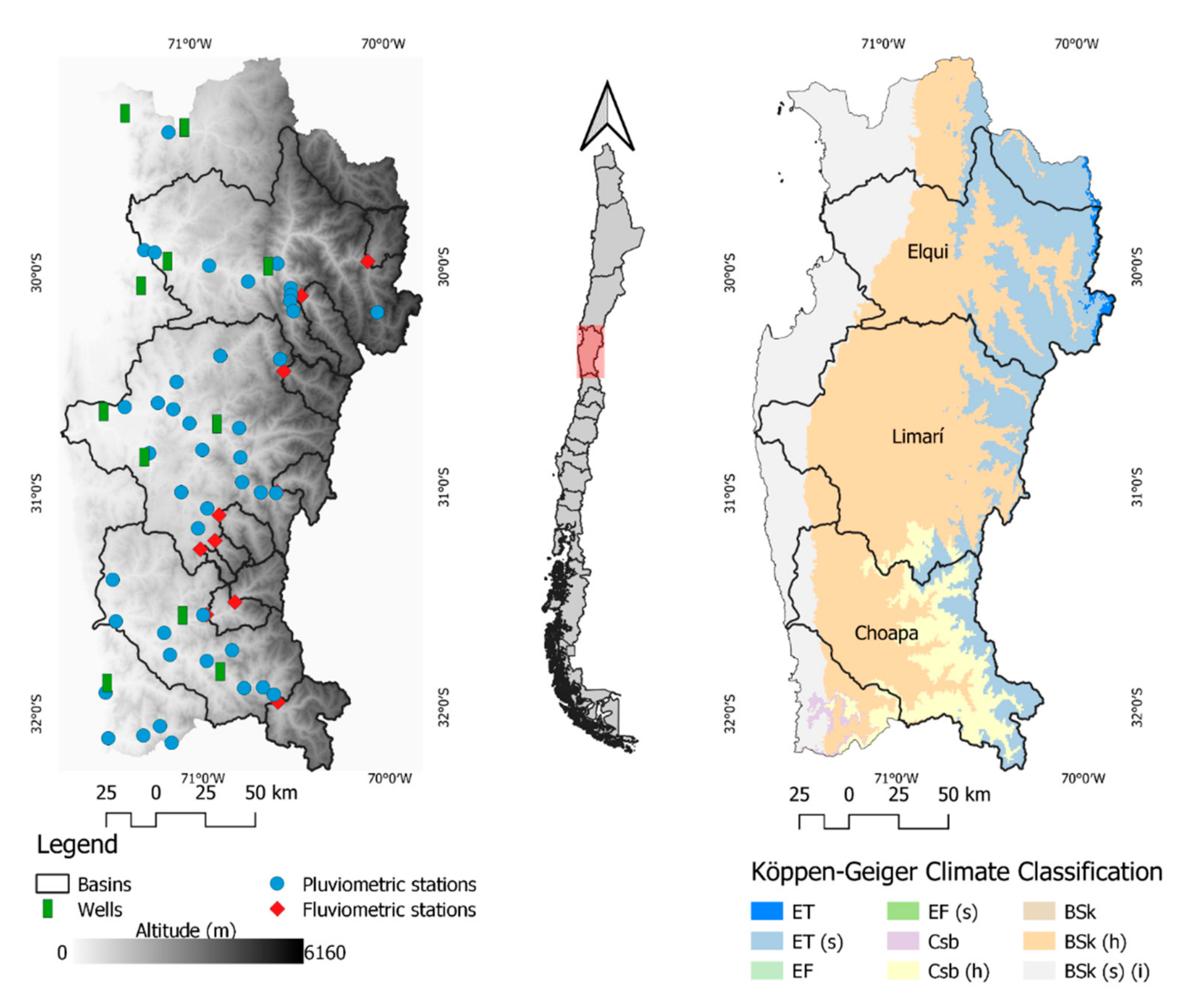
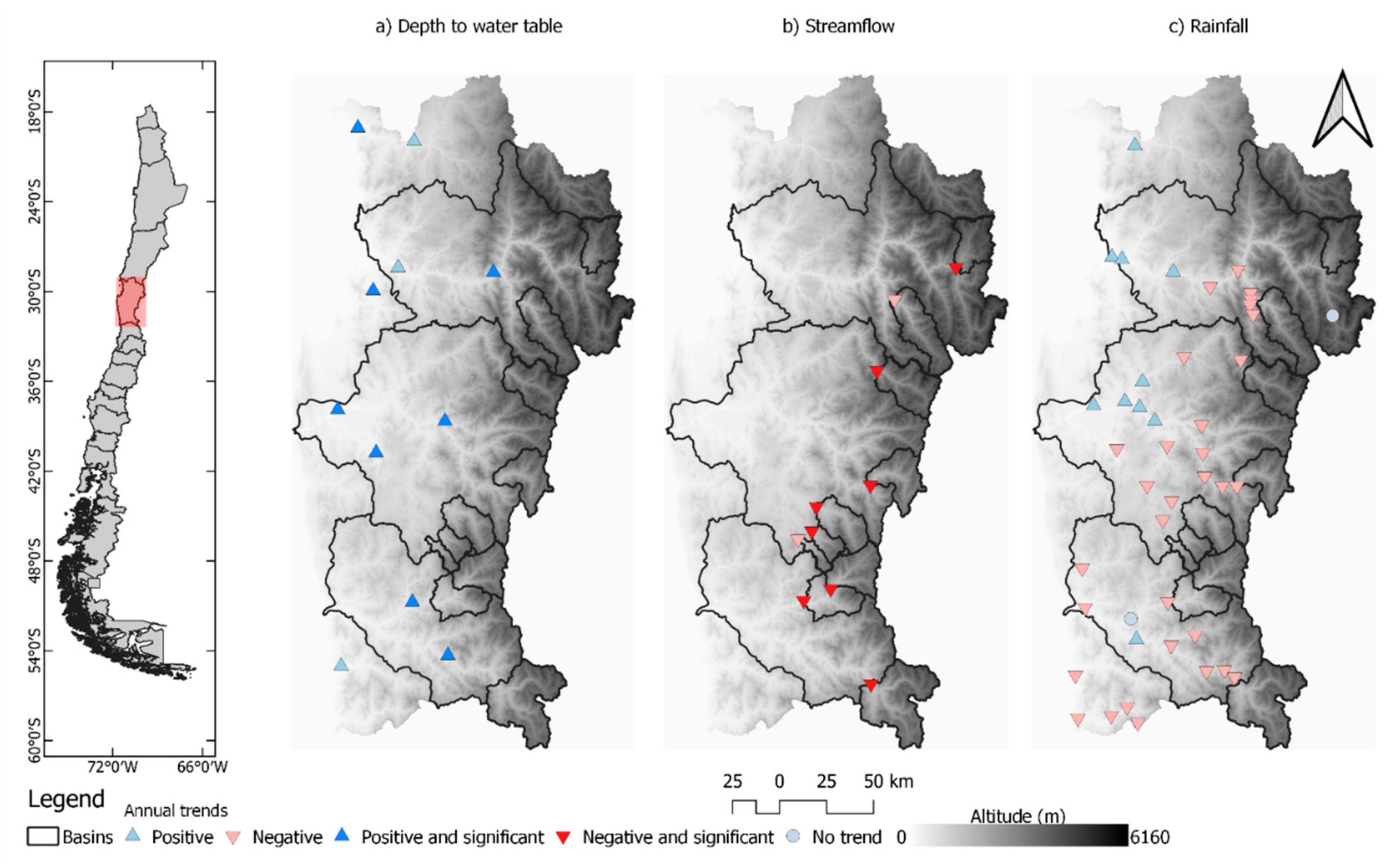
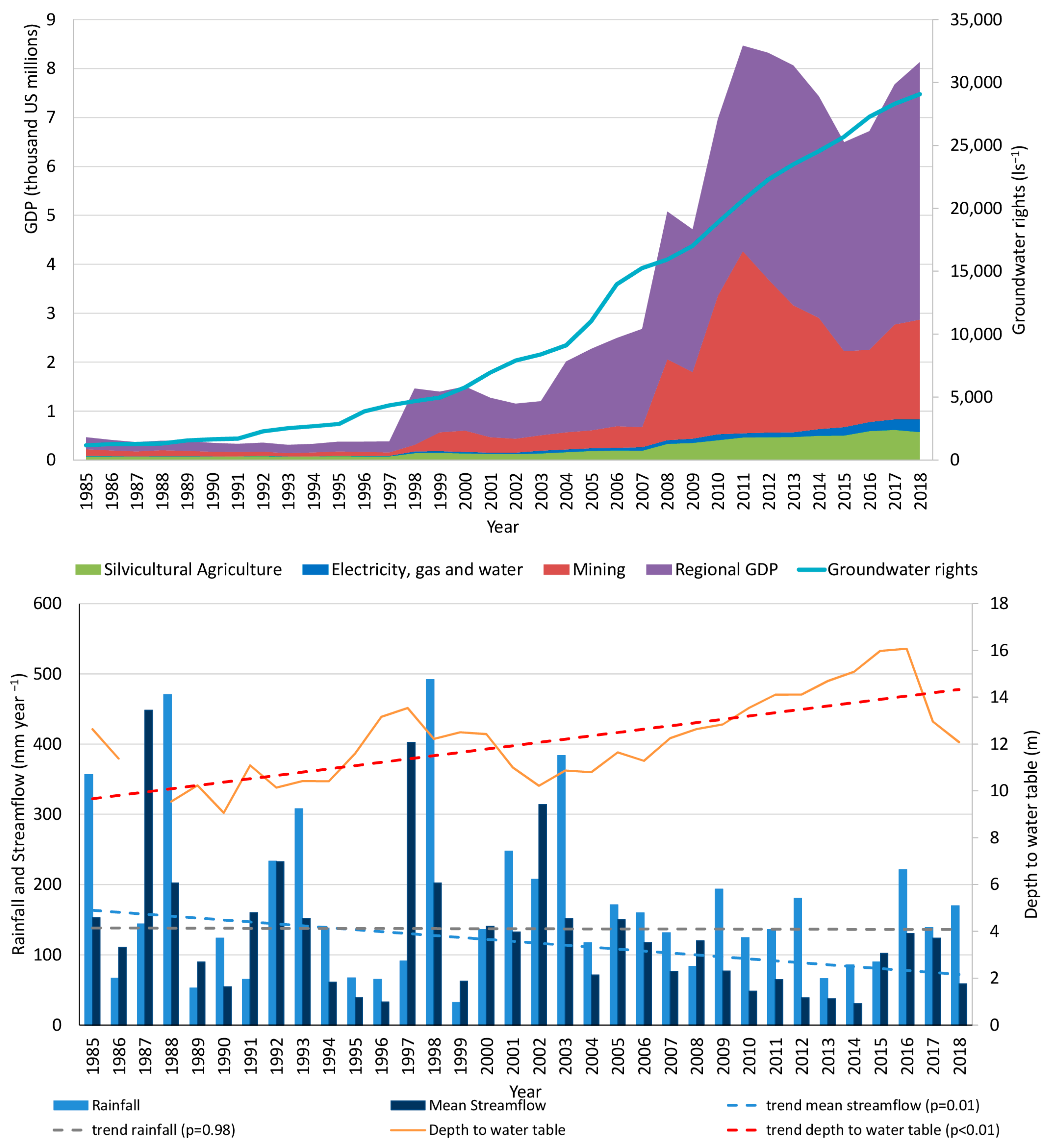
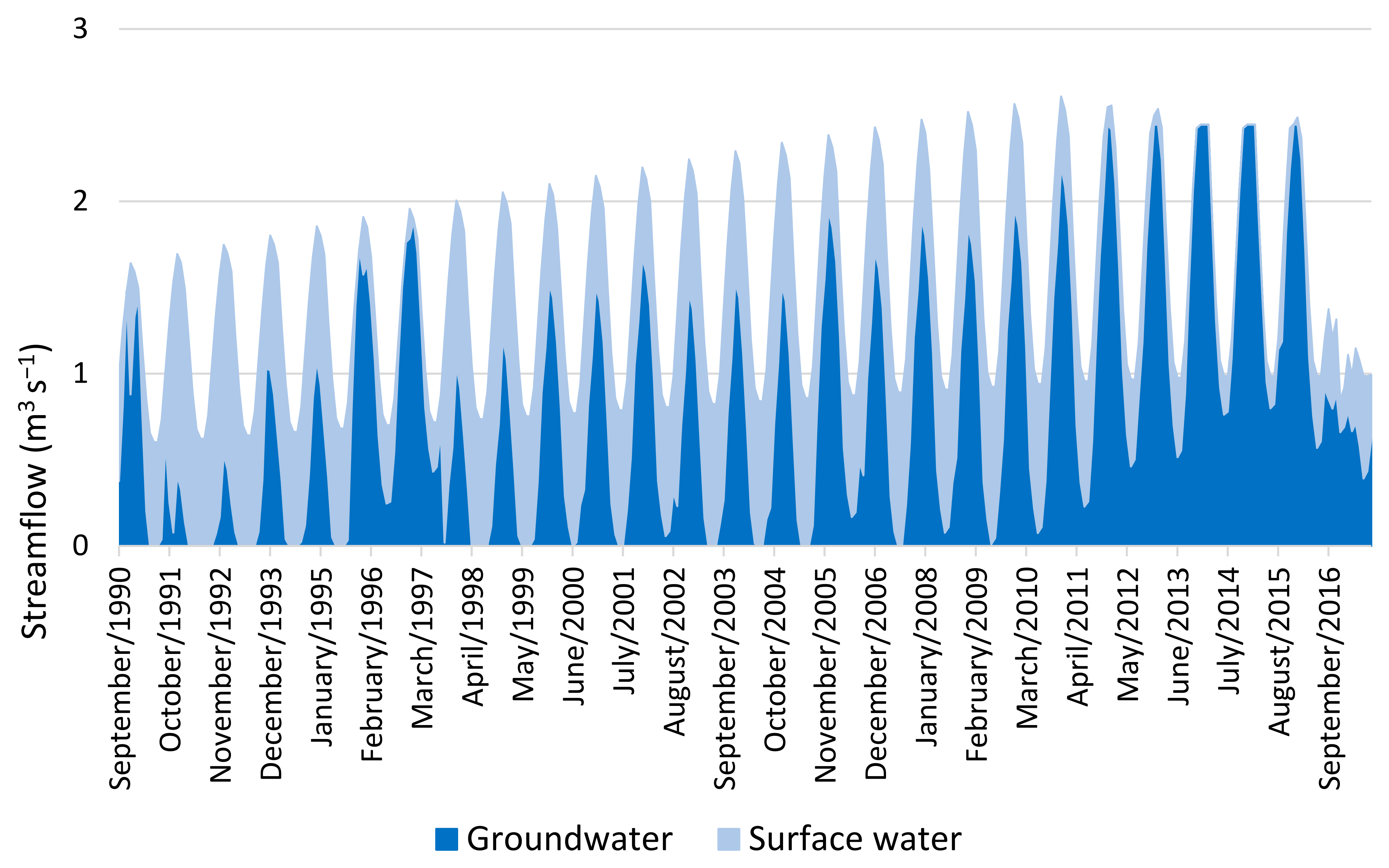
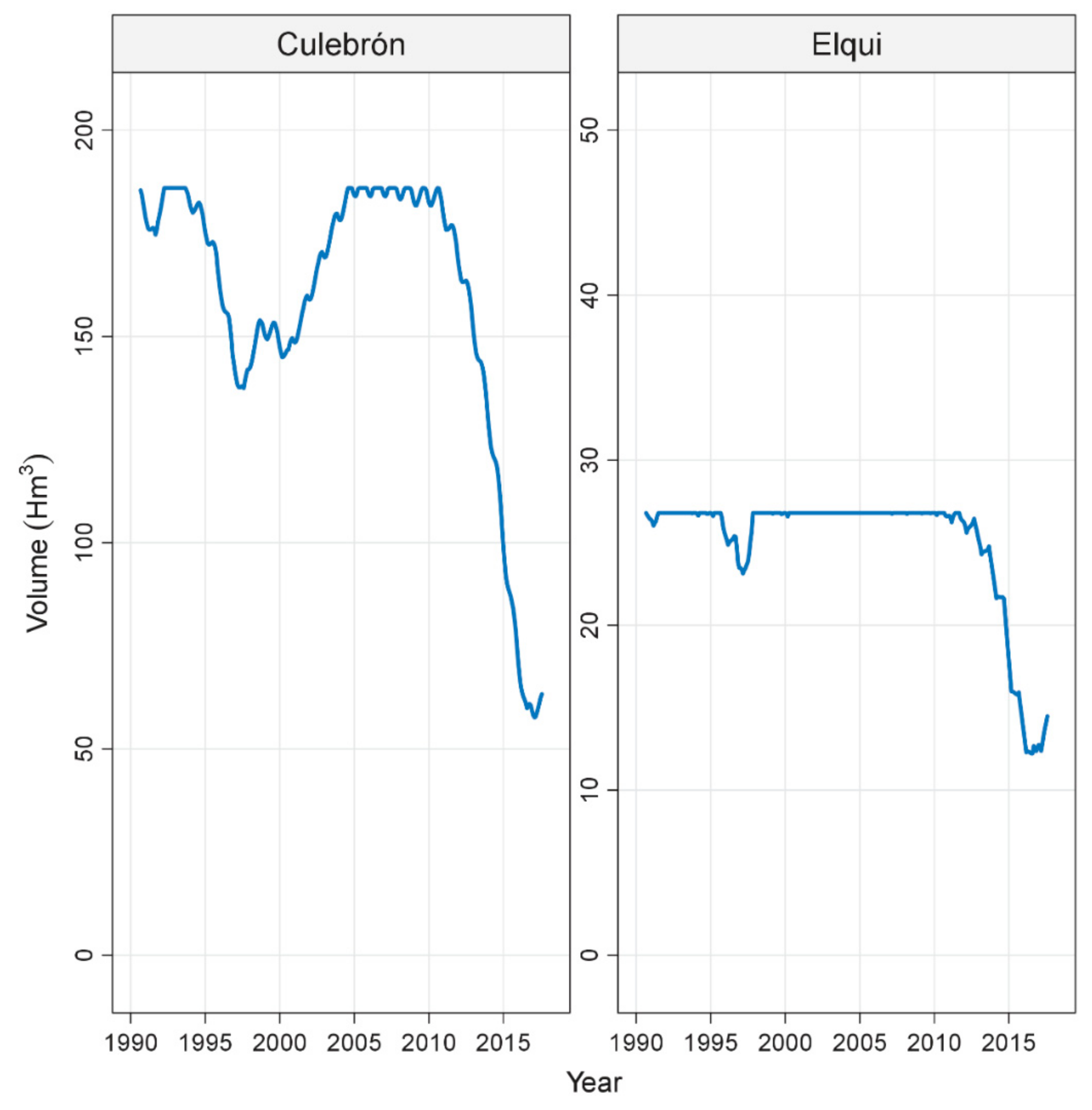
| Variable | Component | Negative | Positive | Positive and Significant | Negative and Significant | No Trends | |
|---|---|---|---|---|---|---|---|
| Rainfall | Monthly | 274 (53.1%) | 193 (37.4%) | 4 (0.8%) | 4 (0.8%) | 41 (7.9%) | |
| Annual | 31 (72.1%) | 10 (23.3%) | 0 (0%) | 0 (0%) | 2 (4.7%) | ||
| Streamflow | Monthly | Min | 102 (85.0%) | 4 (3.3%) | 0 (0%) | 13 (10.8%) | 1 (0.8%) |
| Mean | 80 (66.6%) | 0 (0%) | 0 (0%) | 40 (33.3%) | 0 (0%) | ||
| Max | 85 (70.8%) | 0 (0%) | 0 (0%) | 35 (29.2%) | 0 (0%) | ||
| Annual | Min | 7 (70.0%) | 1 (10.0%) | 0 (0%) | 1 (10.0%) | 1 (10.0%) | |
| Mean | 2 (20.0%) | 0 (0%) | 0 (0%) | 8 (80.0%) | 0 (0%) | ||
| Max | 5 (50.0%) | 0 (0%) | 0 (0%) | 5 (50.0%) | 0 (0%) | ||
| Depth to water Table | Monthly | 0 (0%) | 12 (18.2%) | 54 (81.8%) | 0 (0%) | 0 (0%) | |
| Annual | 0 (0%) | 3 (27.3%) | 8 (72.7%) | 0 (0%) | 0 (0%) | ||
Publisher’s Note: MDPI stays neutral with regard to jurisdictional claims in published maps and institutional affiliations. |
© 2022 by the authors. Licensee MDPI, Basel, Switzerland. This article is an open access article distributed under the terms and conditions of the Creative Commons Attribution (CC BY) license (https://creativecommons.org/licenses/by/4.0/).
Share and Cite
Pizarro, R.; Garcia-Chevesich, P.A.; McCray, J.E.; Sharp, J.O.; Valdés-Pineda, R.; Sangüesa, C.; Jaque-Becerra, D.; Álvarez, P.; Norambuena, S.; Ibáñez, A.; et al. Climate Change and Overuse: Water Resource Challenges during Economic Growth in Coquimbo, Chile. Sustainability 2022, 14, 3440. https://doi.org/10.3390/su14063440
Pizarro R, Garcia-Chevesich PA, McCray JE, Sharp JO, Valdés-Pineda R, Sangüesa C, Jaque-Becerra D, Álvarez P, Norambuena S, Ibáñez A, et al. Climate Change and Overuse: Water Resource Challenges during Economic Growth in Coquimbo, Chile. Sustainability. 2022; 14(6):3440. https://doi.org/10.3390/su14063440
Chicago/Turabian StylePizarro, Roberto, Pablo A. Garcia-Chevesich, John E. McCray, Jonathan O. Sharp, Rodrigo Valdés-Pineda, Claudia Sangüesa, Dayana Jaque-Becerra, Pablo Álvarez, Sebastián Norambuena, Alfredo Ibáñez, and et al. 2022. "Climate Change and Overuse: Water Resource Challenges during Economic Growth in Coquimbo, Chile" Sustainability 14, no. 6: 3440. https://doi.org/10.3390/su14063440






